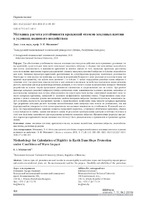| dc.contributor.author | Михневич, Э. И. | ru |
| dc.coverage.spatial | Минск | ru |
| dc.date.accessioned | 2018-04-11T05:54:41Z | |
| dc.date.available | 2018-04-11T05:54:41Z | |
| dc.date.issued | 2018 | |
| dc.identifier.citation | Михневич, Э. И. Методика расчета устойчивости креплений откосов земляных плотин в условиях волнового воздействия = Methodology for Calculation of Rigidity in Earth Dam Slope Protection under Conditions of Wave Impact / Э. И. Михневич // Наука и техника. – 2018. – № 2. - С. 100-105. | ru |
| dc.identifier.uri | https://rep.bntu.by/handle/data/40189 | |
| dc.description.abstract | Для обеспечения устойчивости откосов земляных плотин при воздействии волн применяют различные типы креплений, среди которых чаще всего используют каменную наброску и сборные или монолитные железобетонные плиты. Долговечность и надежность креплений во многом зависят от того, насколько правильно рассчитаны и соответственно выполнены параметры креплений: диаметр материала каменной наброски и толщина железобетонных плит. Значения параметров креплений, рассчитанные по существующим формулам, значительно различаются. Некоторые из этих формул не пригодны для малых водохранилищ Беларуси и дают реальные результаты только для крупных водохранилищ, где высота волн достигает 2 м и более. С целью определения диаметра камня наброски и толщины плит для крепления откосов плотин в зоне активного волнового воздействия предложена новая методика расчета, пригодная для водохранилищ различных размеров, в том числе и малых водохранилищ Беларуси. Методика разработана на основе теории предельного равновесия сдвигающих и удерживающих сил на откосе. При расчете диаметра материала каменной наброски учтены сдвигающие силы: взвешивающее волновое давление, зависящее от высоты волны; влекущая сила потока, образующегося на откосе при откате волны; сдвигающий компонент силы тяжести материала крепления, зависящий от заданного коэффициента заложения откоса. Удерживающие силы определены с учетом основных физико-механических свойств материала наброски: плотности частиц во взвешенном водой состоянии, пористости, внутреннего трения и удерживающего компонента силы тяжести материала крепления. При разработке методики расчета толщины железобетонных плит влекущая сила потока не учитывалась, так как формируемый на поверхности плит поток практически не оказывает влияния на их устойчивость. В нижней зоне откоса, где гидродинамическое давление создается придонной скоростью, устраивают облегченное крепление, обычно в виде наброски из щебня, гравия или мелкого камня. В результате преобразования критерия устойчивости откоса в этой зоне получены зависимости для определения крупности материала наброски. Предложенные формулы для расчета параметров креплений откосов земляных плотин могут быть рекомендованы к применению в проектных организациях. | ru |
| dc.language.iso | ru | ru |
| dc.publisher | БНТУ | ru |
| dc.subject | Земляные плотины | ru |
| dc.subject | Крепления откосов | ru |
| dc.subject | Волновое воздействие | ru |
| dc.subject | Каменная наброска | ru |
| dc.subject | Железобетонные плиты | ru |
| dc.subject | Расчетные формулы | ru |
| dc.subject | Earth dam | en |
| dc.subject | Slope protection | en |
| dc.subject | Wave impact | en |
| dc.subject | Dumped rip-rap | en |
| dc.subject | Reinforced concrete plate | en |
| dc.subject | Calculation formulaе | en |
| dc.title | Методика расчета устойчивости креплений откосов земляных плотин в условиях волнового воздействия | ru |
| dc.title.alternative | Methodology for Calculation of Rigidity in Earth Dam Slope Protection under Conditions of Wave Impact | en |
| dc.type | Article | ru |
| dc.identifier.doi | 10.21122/2227-1031-2018-17-2-100-105 | |
| local.description.annotation | Various types of protection are used in order to ensure rigidity in earth dam slopes and dumped rip-rap and precast and cast-in-situ reinforced plates are the most commonly used for this purpose. Durability and reliability of the protections mainly depend on the fact whether protection parameters have been correctly calculated and correspondingly observed during the process of protection creation, the main protection parameters are material diameter of dumped rip-rap and thickness of reinforced plates. Values of protection parameters calculated in accordance to the existing formulae significantly differ among themselves. Some of these formulae are acceptable for small water reservoirs in Belarus and provide actual results only for large water reservoirs where a wave height reaches two metres and even more. A new calculation methodology which is suitable for Belarusian water reservoirs of various size is proposed with the purpose to determine diameter of dumped rip-rap material and thickness of plates for earth dam slope protection in the zone of active wave impact. The methodology has been developed on the basis of the theory pertaining to limit equilibrium of slope shearing and holding forces. While calculating diameter of dumped rip-rap material the following shearing forces have been taken into account: uplift wave pressure depending on wave height; drag force which is formed on the slope due to back sweep of wave; shearing component of protection material gravity force which is dependent on preselected slope ratio. Holding forces are determined with due account of main physical and mechanical properties of dumped rip-rap material: density of particles in water suspension, porosity, internal friction and holding component of protection material gravity force. While developing methodology for calculation of reinforced concrete plate thickness a drag force has not been taken into account because the flow which is formed on the plate surface does not exert an influence on their equilibrium. Bottom slope zone where hydrodynamic pressure is created by bottom velocity has usually a reduced-weight protection in the form of broken stone, gravel and finely broken stone rip-rap. Dependences for determination of dumped rip-rap fineness have been obtained as a result of slope rigidity criterion conversion. The proposed formulae for calculation of earth dam slope protection parameters can be recommended for application in design organizations. | en |

